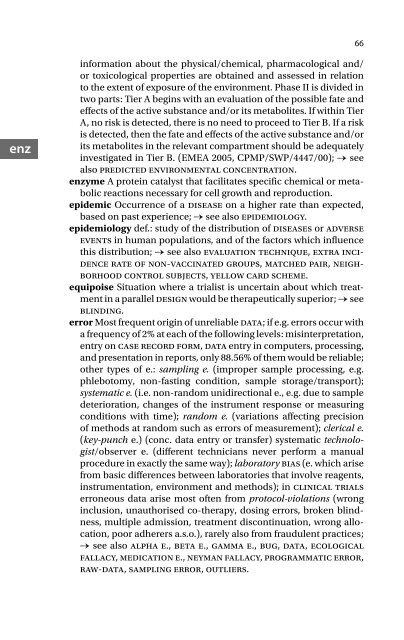220-Dictionary of Pharmaceutical Medicine, 2nd Edition-Gerhard Nahler Annette Mollet-3211898352-S
220-Dictionary of Pharmaceutical Medicine, 2nd Edition-Gerhard Nahler Annette Mollet-3211898352-S
220-Dictionary of Pharmaceutical Medicine, 2nd Edition-Gerhard Nahler Annette Mollet-3211898352-S
You also want an ePaper? Increase the reach of your titles
YUMPU automatically turns print PDFs into web optimized ePapers that Google loves.
66enzinformation about the physical/chemical, pharmacological and/or toxicological properties are obtained and assessed in relationto the extent <strong>of</strong> exposure <strong>of</strong> the environment. Phase II is divided intwo parts: Tier A begins with an evaluation <strong>of</strong> the possible fate andeffects <strong>of</strong> the active substance and/or its metabolites. If within TierA, no risk is detected, there is no need to proceed to Tier B. If a riskis detected, then the fate and effects <strong>of</strong> the active substance and/orits metabolites in the relevant compartment should be adequatelyinvestigated in Tier B. (EMEA 2005, CPMP/SWP/4447/00); → seealso predicted environmental concentration.enzyme A protein catalyst that facilitates specific chemical or metabolicreactions necessary for cell growth and reproduction.epidemic Occurrence <strong>of</strong> a disease on a higher rate than expected,based on past experience; → see also epidemiology.epidemiology def.: study <strong>of</strong> the distribution <strong>of</strong> diseases or adverseevents in human populations, and <strong>of</strong> the factors which influencethis distribution; → see also evaluation technique, extra incidencerate <strong>of</strong> non-vaccinated groups, matched pair, neighborhoodcontrol subjects, yellow card scheme.equipoise Situation where a trialist is uncertain about which treatmentin a parallel design would be therapeutically superior; → seeblinding.error Most frequent origin <strong>of</strong> unreliable data; if e.g. errors occur witha frequency <strong>of</strong> 2% at each <strong>of</strong> the following levels: misinterpretation,entry on case record form, data entry in computers, processing,and presentation in reports, only 88.56% <strong>of</strong> them would be reliable;other types <strong>of</strong> e.: sampling e. (improper sample processing, e.g.phlebotomy, non-fasting condition, sample storage/transport);systematic e. (i.e. non-random unidirectional e., e.g. due to sampledeterioration, changes <strong>of</strong> the instrument response or measuringconditions with time); random e. (variations affecting precision<strong>of</strong> methods at random such as errors <strong>of</strong> measurement); clerical e.(key-punch e.) (conc. data entry or transfer) systematic technologist/observere. (different technicians never perform a manualprocedure in exactly the same way); laboratory bias (e. which arisefrom basic differences between laboratories that involve reagents,instrumentation, environment and methods); in clinical trialserroneous data arise most <strong>of</strong>ten from protocol-violations (wronginclusion, unauthorised co-therapy, dosing errors, broken blindness,multiple admission, treatment discontinuation, wrong allocation,poor adherers a.s.o.), rarely also from fraudulent practices;→ see also alpha e., beta e., gamma e., bug, data, ecologicalfallacy, medication e., neyman fallacy, programmatic error,raw-data, sampling error, outliers.


